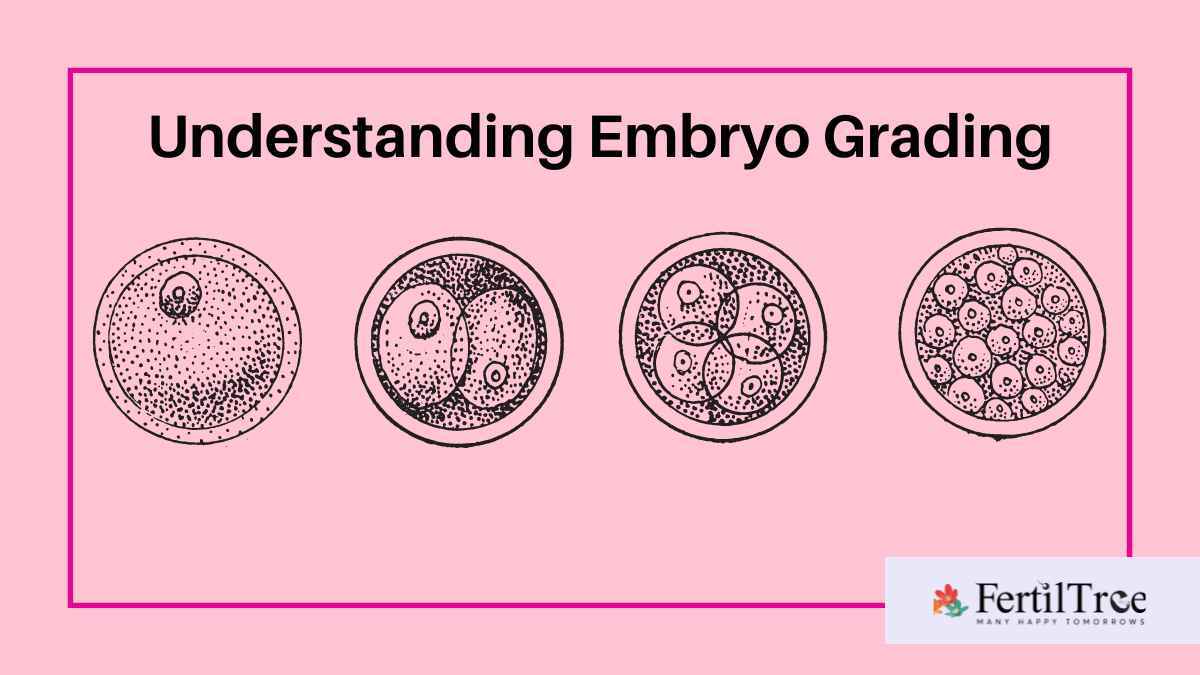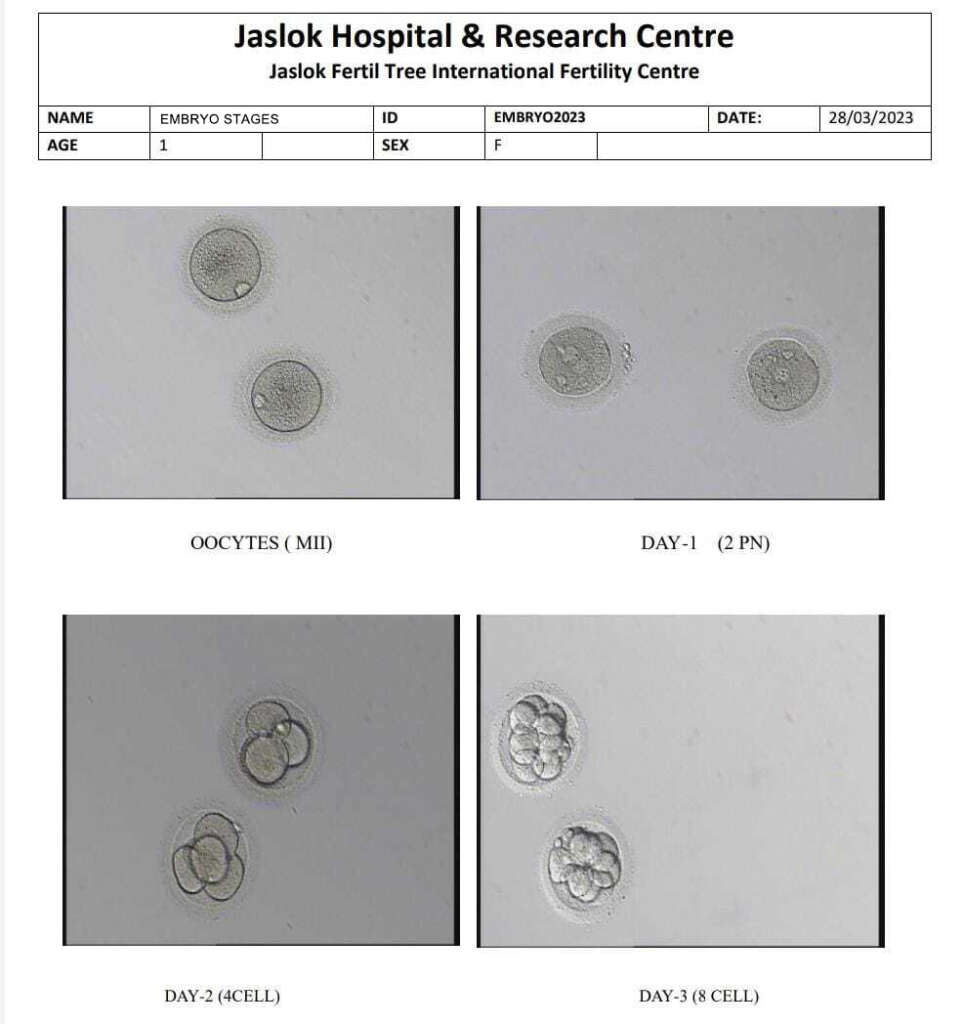
Embryo grading helps fertility specialists to evaluate the quality of embryos so that the best embryo(s) is/are transferred. They rely on this tool for desirable outcomes. Embryos are checked and ranked based on visual criteria with the help of a high-powered microscope.
Through microscopic examination, embryos are categorized as ‘good’, ‘average’ or ‘poor’ quality based on certain criteria such as cell size, shape and number of cells. On Day 3, an embryo is referred to as a Day 3 Embryo or an 8-cell cleaving embryo. By Day 5, it’s known as a Blastocyst or a Day 5 Embryo.
Embryo Grading: Table Of Content
Understanding embryo grading systems
The embryo grade system looks at development in two stages. On day 3 of embryo development, they examine the cell number and arrangement. Day 5 is when they check if it’s reached the blastocyst stage.
The Gardner Embryo/Blastocyst Grading System is the go-to for embryologists when assessing embryo development to decide implantation. The system has three parts, 2 letters and 1 number (e.g. 4AA, 2BA, 5AB):
- Blastocyst development stage: 1 – 6 (with 5 being the most developed)
- ICM (Inner Cell Mass) quality: A – C (A being the best)
- TE ( Trophectoderm) Quality: A – C (A being the best)
The number indicates the blastocyst development stage or the degree of the expansion of the blastocele, which is the fluid-filled space within the blastocyst.
- Early blastocyst: the blastocele is less than half the volume of the embryo.
- Blastocyst: the blastocele is greater than or equal to half of the volume of the embryo.
- Full blastocyst: the blastocele completely fills the embryo.
- Expanded blastocyst: the blastocele volume is larger than the early embryo’s, and the zona pellucida is thinning.
- Hatching blastocyst: the trophectoderm has started to herniate through zona pellucida.
- Hatched blastocyst: the blastocyst has completely escaped from the zona pellucida.
After the number comes two letters, these letters are for the two parts of the day-5 blastocyst:
- The Inner Cell Mass (ICM), which grows into the fetus
- The Trophectoderm (TE), which becomes the placenta.
- For the IMC letter grade, A is the highest grading which means the embryologist observed numerous cells, tightly packed. B means there were several cells tightly packed. And C indicates very few cells. Blastocyst embryo grading is helpful. However, the potential of the embryo to implant and form a healthy baby is difficult to predict using grading by itself.
Embryos graded with AA (3AA, 4AA, 5AA, 6AA) have the best chances of success. Embryos graded as AB or BA (3AB, 4AB, 5AB, 6AB, 3BA, 4BA, 5BA, 6BA) seem to have a lower chance of pregnancy but a nearly similar chance of live birth. Embryos graded as BB (3BB, 4BB, 5BB, 6BB) still have a good chance of success. While those graded BC or CB have a much lower chance of implantation.
Is embryo grading subjective?
Grading an embryo means studying the embryo in order to judge its appearance – which can be subjective. Better-grade embryos have a better chance of implanting.
Successful embryo implantation requires both synchronous development and interaction between the hatched blastocyst and the endometrium. There are many reasons implantation might not be successful, ranging from uterine defects, metabolic issues, infections, immunity concerns and blood clotting problems – just to name a few. Also, severe male factors can impact the genetic and morphology of the embryo.
Poor-quality embryos may be able to implant depending on the woman’s age, quality of the endometrium, and stage of the embryo. Sometimes good quality embryos may not implant because they may be genetically abnormal.
When is embryo quality determined?
Generally, the embryo’s quality is determined on day 3 or Day 5 after egg retrieval. The reason is that until day 3, most of the embryo’s growth and development relates to the egg contents. From the end of day three onwards, the genome of the sperm enters the embryo’s DNA, and the embryonic genome is activated. On day 5, embryo grading is done by measuring blastocyst expansion, the condition of the trophectoderm, and the inner cell mass.
Different IVF grading systems for Day 3 & Day 5?
Embryo grading systems can determine which embryos to transfer and/or freeze. Embryo transfer can be done on Day 3 or Day 5 of the retrieval. Because embryos are developmentally different on these days, we have different grading systems for Day 3 and Day 5 embryos.

Day 3 Embryo Grading: Quality of Division
Day 3 embryos are referred to as the “cleavage stage” embryos because the cells in the embryo are dividing (or cleaving), but the embryo itself is not growing in size. Even with genetic material replicating and cells dividing, the volume of the embryo remains unchanged compared to that of the unfertilized egg.
Cleavage stage embryos are graded using 2 criteria: the number of cells in the embryo and the cell appearance under a high-power microscope. While the cell number is objective, the score for appearance is subjective, using a score of 1-4. Typically, a good, normal growing day 3 embryo will contain between 6 and 10 cells
The embryo grade refers to how the cells in the embryos look. A grade 1 embryo is one in which all of the cells are equal, the cell junctions are tight, and there is no fragmentation of the embryo.
Day 5 Embryos
Embryos continue to divide, and the number of cells increases and also differentiate into specific cell types. At this point, the embryos outgrow the space inside the zona pellucida (ZP or “shell”), which is the shell of the embryo. They start to expand, and the ZP thins out to allow the blastocyst hatche out of this membrane to get ready to implant in the uterine lining.
A blastocyst is distinguished by its two clearly defined cell components and a fluid cavity. The quality of the blastocyst depends on how clear the structures of the blastocyst look. As the blastocyst progresses, the two cellular masses divide, and the fluid cavity enlarges. The Inner Cell Mass (ICM) becomes the fetus and the Trophectoderm (TE) becomes the placenta.
What Is the Inner Cell Mass (ICM)?
The ICM is essential to early embryo development. It’s the group of cells within the blastocyst that will form into the fetus with all its organs and tissues.
What Is the Trophectoderm (TE)?
The trophectoderm (TE) is the outer layer of the blastocyst which forms into the placenta and other extraembryonic membranes.
Are both of these cell types necessary to establish a healthy pregnancy?
Both ICM and TE should be well-formed for the pregnancy to be successful.
Embryo grading at the blastocyst stage requires an in-depth assessment of three components: the inner cell mass (ICM), the trophectoderm (TE) and the fluid-filled cavity or blastocoel.
Blastocyst transfer results in high pregnancy rates. Since only a single blastocyst is usually transferred, it almost eliminates the risk of multiple births.
The Gardner Blastocyst Grading System
The most common system for ranking the quality of blastocyst stage embryos is the Gardner grading system. According to the Gardner system, each blastocyst embryo is assigned 3 separate quality scores:
1. Blastocyst development stage – a range from 1 – 6 (with 5 being the most developed)
2. Inner cell mass (ICM) score, or quality – range A – C (A being the best)
3. Trophectoderm (TE) score, or quality – range A – C (A being the best)
So the least advanced blastocyst would be 1CC and the most would be 6AA. However, it’s generally preferred to do embryo transfer as they reach level 5 (hatching). Blastocysts that are well-developed and with healthy internal structures are more likely to develop into successful pregnancies. Studies show that transfers using excellent grade blastocysts (greater than 3AA, for example), the clinical pregnancy rates were excellent, whereas average grade blastocysts (for example, 4BB, 4AC, 4CA, 2AB, 2BA) gave less successful implantation. Poor quality blastocysts (3BC, 4CB, 4CC, 2BB) achieved very low pregnancy rates.
Typically an A-grade blastocyst has a grade consisting of a number and two letters, for example: 4AA. The number explains the degree of embryo expansion of the blastocyst cavity and its progress in hatching out of the zona pellucida on a scale from 1-6; as the embryo expands, the degree of expansion increases. The first letter indicates on a scale from A to C (A being the highest) the quality of the inner cell mass, which potentially becomes the cells that form the embryo’s body after implantation.
The second letter is also on a scale from A to C (A being the highest). This grade indicates the quality of the trophectoderm, the cells that give rise to the placenta and extraembryonic tissues after implantation.
A morphologically “perfect” day 5 embryo transfer would be a 4AA, good expansion, excellent inner cell mass, and trophectoderm. When a blastocyst scores 5AA on day five, the blastocyst starts to “hatch” with normal appearing inner cell mass and trophectoderm. Therefore when a blastocyst scores a 6AA on day five, the blastocyst is completely “hatched” with an excellent inner cell mass and trophectoderm.
How important is embryo grading?
Embryos graded with AA (3AA, 4AA, 5AA, 6AA) have the best chances of success. Embryos graded as AB or BA (3AB, 4AB, 5AB, 6AB, 3BA, 4BA, 5BA, 6BA) seem to have a lower chance of pregnancy but a nearly similar chance of live birth. Embryos graded as BB (3BB, 4BB, 5BB, 6BB) still have a good chance of success. While those graded BC or CB have a much lower chance of success. Embryo grading helps to distinguish between good, average, and poor embryos in order to help the embryologist select an embryo which has the highest chance of resulting in a healthy baby.
Embryo Grading Success rates by grades
For embryo grades of excellent, good, average and poor, the clinical pregnancy rates and live birth rates were in descending order as per Xiao-Wei Zhang et.al 2018.
David Reichman et.al 2017 found blastocyst grading of embryos and particularly inner cell mass grade (the first letter), is a useful predictor of a successful pregnancy.
Read more:
IVF Step-by-Step Process IVF vs IUI: The Complete GuideFAQs on Embryo grading and Success Rates
How are embryos graded?
What is a grade 1 embryo in IVF?
Does embryo grading matter?
What grade of embryos can be frozen?
What is the best grade embryo in IVF?
Can an 8 cell grade 1 embryo have a successful implantation?
Can day 3 embryos be graded?
a) The number of cells in the embryo: A Day 3 embryo that is growing normally contains between 6 and 10 cells.
b) Greater the fragmentation in the embryo, the less the chances of implantation.
c) Whether the cells are “symmetrical” – i.e. that they’re all roughly the same size as each other
Can the grade of embryo change with time?
All About Day 2 embryo grading
What are Grade B (3BB, 4BB, 5BB, 6BB) embryo success rates?
References
- CRGW. Accessed April 10, 2023. https://crgw.co.uk/treatment/embryo-freezing/.
- Donna. “Understanding Embryo Grading – Genesis Fertility New York.” GENESIS Fertility & Reproductive Medicine, July 29, 2022. https://www.genesisfertility.com/blog/understanding-embryo-grading/.
- Houghton, Bill. “Embryo Grading & Success Rates: The Sensible Guide.” SENSIBLE Surrogacy Agency, November 23, 2022. https://www.sensiblesurrogacy.com/quality-grade-of-embryos/.
- “IVF Embryo Grading System at San Diego Fertility Center®.” San Diego Fertility Center. Accessed April 10, 2023. https://www.sdfertility.com/fertility-treatments/eset/embryo-grading.
- Lewis, Elisa. “Embryo Grading in IVF: Which Embryos Are Good?” Infertility Aide, July 27, 2021. https://www.infertilityaide.com/blog/embryo-grading-in-ivf-which-embryos-are-good.
- Natalist. “Guide to IVF Embryo Grading.” Natalist. Natalist, March 20, 2021. https://natalist.com/blogs/learn/guide-to-ivf-embryo-grading.
- Schorsch, Kelly. “Understanding the Blastocyst Grading Scale: The IVF Process.” InVia Fertility, July 18, 2022. https://www.inviafertility.com/blog/blog/embryology/kellyschorsch/understanding-the-blastocyst-grading-scale/.
- “Understanding IVF Embryo Grading Systems | ARC® Fertility.” Accessed April 10, 2023. https://www.arcfertility.com/understanding-embryo-grading/.
Book A Consultation

